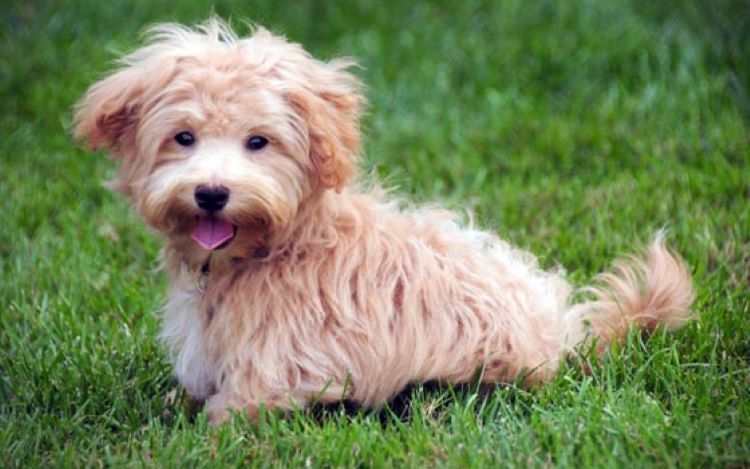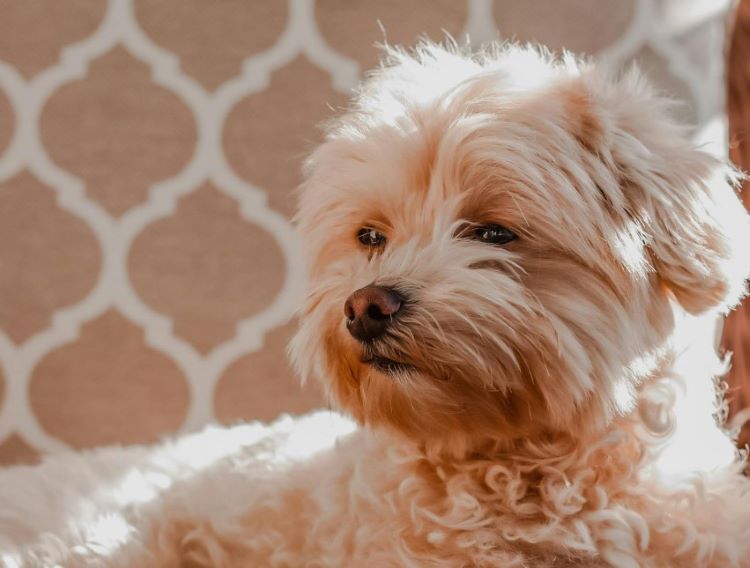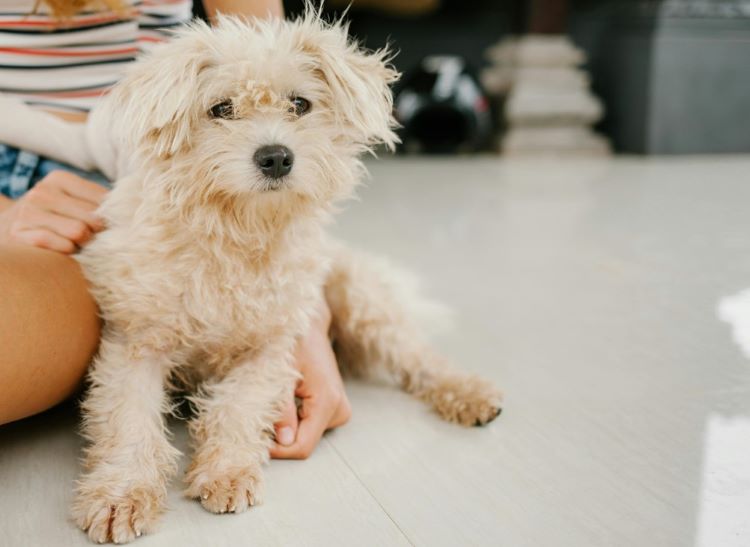Ready to help treat your pet to a healthy life?
Get to Know the Maltipoo: a Dog Breed Guide
By : Trupanion Staff | Updated Sep 5, 2024

Dog breeds have been crossed throughout history, but only some of these mixes have gone on to become a breed in their own right. A more recent (and highly popular!) example is the Maltipoo. This sweet, playful dog comes from combining the intelligent Poodle with the perky Maltese. The result is a spunky and quick-witted dog that acts like a puppy well into their older years. Affectionate and gentle while still energetic, these dogs do well as therapy dogs and thrive with constant human companionship.
If you're considering adopting a Maltipoo, want to learn more about your current dog, or are just curious about these unique pups, this Maltipoo dog breed guide has you covered!
10 fun facts about the Maltipoo
- What’s in a name? Maltipoos also go by Moodle, Malt-A-Poo, Maltoodle, or Maltipoodle!
- These are small dogs, generally weighing between 5 and 15 lbs. (2.27 - 6.8 kg) and no taller than 15 inches (38 cm) when fully grown.
- As a result of their genetics, Maltipoos have similar lifespans to Maltese and Poodles, usually reaching 10 to 15 years.
- There are two types of Maltipoos. First-generation Maltipoo puppies are a cross between a purebred Maltese and a purebred Poodle (either Toy or Miniature size). Second-generation Maltipoos are born to two Maltipoo parents.
- The Maltese breed, half of the Maltipoo’s lineage, is an ancient breed believed to have been used in the development of a few different small dog breeds, like the Havanese, Bichon Frise, Yorkshire Terrier, and Coton de Tulear.
- The Maltipoo has become a popular designer dog breed, as the breed mix results in a dog that looks and acts like a puppy well into their older years.
- Though they are not truly hypoallergenic, Maltipoos are often considered a good choice for people with allergies because they are low shedding. However, regular grooming is essential to keep their coat in good condition.
- They have hair instead of fur, which typically grows at a rate of 1/2 inch (1.27 cm) a month. Their hair needs routine trimming and grooming to prevent matting and promote a healthy coat.
- Thanks to their Poodle parentage, Maltipoos tend to be highly intelligent and easy to train. They can learn commands and tricks quickly, and they can make excellent therapy pets and working dogs in certain environments.
- Rihanna’s Maltipoo, Oliver, was named one of the Top 10 Celebrity Pets of 2012.
History of the Maltipoo
The Maltipoo first appeared in the United States at the end of the 20th century. As of 2024, no single person or breeding organization has taken credit for the development of the Maltipoo. What is known is that sometime during the late 1980s and early 1990s, breeders sought to capture the small stature and soft coat of the Maltese along with the intellect of the Poodle. It is also believed that the two dogs were crossed in the hopes of creating a new dog with extra hypoallergenic qualities.
Not much more is known about the dog's origins except that they became popular along with the rise of other “designer dog breeds”. Along with this trend, the Maltipoo gained further prevalence as one of the smaller options of the doodle craze. For the unfamiliar, these are different kinds of dogs that come from crosses with Poodles. The Poodle has proven to be an excellent choice to cross with other breeds due to its low-shedding coat, great temperament, and variety of sizes. For this reason, there’s been an explosion of doodles in the designer dog breed world, such as the Labradoodle, Goldendoodle, and Bernadoodle. And the Maltese, an ancient, social and loving dog from the island of Malta, was an obvious choice to crossbreed with the Poodle. The result is a fun, loyal, puppy-like breed that makes an excellent companion dog.
Are they a real dog breed?
Even though we refer to Maltipoos throughout this guide as a dog breed, the truth is that they are not considered an official breed by the American Kennel Club (AKC), Canadian Kennel Club (CKC) nor most other kennel clubs in the world. They are instead viewed as a designer dog hybrid.
Naturally, this doesn't mean Maltipoos will never be an "official" dog breed. Most modern-day breeds that are recognized by kennel clubs around the world started out as mixes or designer dogs themselves.
Similar dog breeds
- Maltese
- Miniature Poodle
- Cockapoo
- Labradoodle
- Goldendoodle

Behavior and training
Because these dogs are a mix, their appearance and temperament can vary widely depending on the traits they inherit from each parent. Maltipoos inherit a combination of the Maltese and Poodle behavior tendencies, but there is no way to predict how much of each breed’s typical training idiosyncrasies a Maltipoo will have. Canine behavior is also affected by environment, learning, and a dog’s individual personality. However, both parent breeds are intelligent, eager to please, and loyal dog breeds that are a joy to train and live with. Your own Maltipoo might have a tendency to chase a squirrel or two (as the Maltese breed was historically used for rodent control), but with consistent and positive training, a Maltipoo will thrive and be an excellent companion.
How do Maltipoos get along with other dogs and humans?
The Maltese parent breed is typically quite social, while the Poodle tends to be a bit more reserved when meeting new people and other animals. Like all dog breeds, the Maltipoo needs proper proactive exposure to new sights, sounds, people, dogs, and other animals as a young puppy to help prevent any future fear from developing. By having lots of positive exposure as a puppy, they’ll learn that new people, places, and other animals aren’t anything to be worried about.
Their smaller size can make living with young children challenging, as they can easily be injured with rough handling or get worried about loud noises and excessive movement. However, they will do well with children if they are socialized from a young age, and the children are respectful in their handling of the dog. Young children and dogs should always be supervised, and it’s helpful for a dog to have their own “safe space” where they can go when they need some quiet time.
Many Maltipoos can do well with other animals, including cats, when properly introduced. Early socialization in puppyhood is also key here. Keep in mind that these dogs don’t seem to understand how small they really are. It’s therefore highly important to supervise any play with other dogs to make sure they don’t inadvertently get hurt or overreact if they get overwhelmed.
Exercise requirements
Maltipoos have lots of energy and spunk for their size. Fortunately, their smaller size makes it easy to provide them with adequate exercise, simply by walking around the home or out and about town. These dogs adore play, so playing with their people is often enough to satisfy their exercise needs and build the human-canine bond. Grab a tug toy, flirt pole, or a ball for a game of fetch, and your Maltipoo is bound to be content.
Keep in mind that their petite size means they shouldn’t be engaging in activities that require jumping from heights, including from furniture or out of the car. Their small stature makes it easy for them to injure themselves and develop more serious health issues with age. Maltipoos can even be seriously injured in jumps or a fall from their owner’s arms. They’ll appreciate easier access to their favorite couch nesting spots with a ramp or dog stairs, and should be lifted in and out of cars and on and off furniture.
Mental enrichment
Maltipoos love to be entertained (and take pleasure in entertaining their people), so providing mental enrichment and brain games will prevent unwanted puppy behaviors from developing. Keep their brain sharp by teaching new tricks, attending obedience classes, joining a dog sport, and providing dog puzzles and interactive toys. Change out the toys and puzzles periodically to provide much-needed variety for these intelligent dogs.
Common behavioral issues
Maltipoos can be a bit on the chatty side, thanks to their Maltese genes — and they can bark a lot. For this reason, they do well working as alert dogs for hearing-impaired owners. To avoid potential problems, they simply need to be taught what to do instead of barking (being quiet, or a nice sit-stay) when someone, for example, comes to the door. Their sharp intellect makes this type of training fairly easy.
Though some owners don’t initially see the need for training a small dog, all dogs benefit from training programs and practices to help build good habits and establish bonds with their humans. Inappropriate and aggressive behaviors such as nipping, biting, or resource guarding by Maltipoos are often seen as “cute” because they don’t cause serious injury as a larger dog would. However, a dog displaying aggressive behaviors is usually doing so out of fear or insecurity. For the overall well-being of a Maltipoo (and everyone’s safety!), it's important that they aren’t forced to display these behaviors in an effort to be “cute” or “go viral” on social media. Responsible Maltipoo owners will help their dogs feel safe and teach them appropriate behaviors, using proper management and positive reinforcement methods.
Due to their love of companionship and their sociability, Maltipoos need positive exposure to alone time from puppyhood on to help prevent or minimize any separation anxiety from developing. It’s much easier to prevent than to treat once it’s started. Make alone time a positive and relaxing experience for your Maltipoo.
Activities for Maltipoos
These eager pups tend to do very well in a variety of size-appropriate activities and sports:
- Small dog agility
- Trick training
- Canine freestyle
- Rally obedience
- Conformation (dog shows)
- Flyball

Maltipoo care tips: health and grooming
As with all types of dogs, Maltipoos are more prone to some health issues than others. It is important to keep up with routine veterinary care as well as protect your dog with a good pet insurance plan in case of any surprises. Their fast-growing coats also require regular grooming in order to prevent matting and other issues that could negatively affect their health.
Common health conditions
The exact health conditions any particular Maltipoo is at risk for will depend on their lineage and lifestyle. This is why it's so important to adopt from responsible dog breeders and make your pet's health a priority throughout their lifetime. That said, the average Maltipoo has similar health risks as Poodles and Maltese dogs. Commonly seen health conditions among these pups include (but are not limited to) the following:
- Progressive Retinal Atrophy (PRA) — An eye condition that can lead to vision loss and blindness over time. It is common in both Maltese and Poodles.
- Patellar Luxation — When the kneecap (patella) dislocates or moves out of its normal position, causing pain and mobility issues. Small breeds, like Maltipoos, are especially prone to this condition.
- Legg-Calvé-Perthes Disease — Where the blood supply to the femur is reduced, leading to the degeneration of the hip joint. It can cause pain and lameness, often requiring surgery.
- Dental Issues — Small dogs like Maltipoos are more likely to suffer from dental problems, including gum disease and tooth decay. Regular dental care, including brushing and professional cleanings, is important.
- White Shaker Syndrome — A neurological disorder more commonly seen in small, white dogs like Maltese and Poodles. It causes tremors, often affecting the entire body. While often alarming, it's generally treatable with medication.
- Hypothyroidism — A condition common in many small breeds, where the thyroid gland doesn't produce enough hormones. This leads to symptoms like weight gain, lethargy, and skin issues.
- Allergies — Maltipoos can be prone to food, environmental, or contact allergies, which may result in skin irritations, excessive itching, or gastrointestinal problems.
- Collapsing Trachea (Tracheal Collapse) — A condition where the trachea (windpipe) weakens and can collapse inward, leading to coughing or breathing problems. It is especially common in Maltese and other small dog breeds.
Coat care
The Maltipoo can inherit a variation of the long and wavy Maltese coat or the more wiry and curly Poodle coat. Maltipoos are classified into three different coat types: soft and silky, thick and curly, or wiry and wavy. Since both originating breeds have a single-layer coat, the Maltipoo does as well. It’s low-shedding and will keep growing instead of shedding like double-coated breeds. Maltipoos can have any color or pattern that is seen in the Poodle breed, such as parti-color (a color pattern on top of white), chocolate, apricot, blue, and black, but many are all-white or mostly white because of the Maltese’s white coat.
The combination of two higher-maintenance coats from the Maltese and Poodle means a Maltipoo requires consistent grooming to keep it in tip-top shape. If a Maltipoo coat is allowed to grow long, it requires thorough daily combing (down to the skin) to prevent matting and tangles. Many Maltipoo owners opt to have their dog groomed in the popular “puppy cut” (a short length all over the body). Professional grooming should be done every 4 to 6 weeks, depending on the owner’s preference for coat length. Start practicing positive and calm grooming with your Maltipoo puppy to make lifelong grooming easy and stress-free. Using a slicker brush and a pin comb can help make daily coat maintenance easier and pain-free for both you and your pet.
The breed is also prone to brown discoloration of tear staining, which is common in the Maltese and Poodle parent breeds. Tear staining happens when there is either an overproduction of tears from the eyes and/or a problem with the drainage of tears from the eyes. Both of these problems can be caused by a variety of underlying conditions, like allergies or abnormal hairs around the eyes. The resulting chronic wetness on the skin below the eyes creates the perfect environment for bacteria and yeast to overgrow. This can cause an infection, which further contributes to the brown discoloration of “tear staining.”
Maltipoos in pop culture
The Maltipoo has risen in prevalence over time, including in the media (especially commercials) and in the homes of famous figures.
Famous Owners of the Maltipoo
- Lucy Hale (Actress)
- Michele Kwan (Figure Skater)
- Ellen Degeneres (Entertainer)
- Rihanna (Singer)
- Blake Lively and Ryan Reynolds (Actors)
- Vanessa Hudgens (Actress)
- Ashley Tisdale (Actress)
- Brooke Burns (Model)
- Jessica Simpson (Singer)
